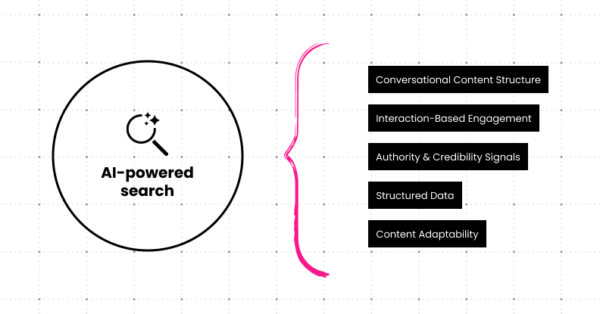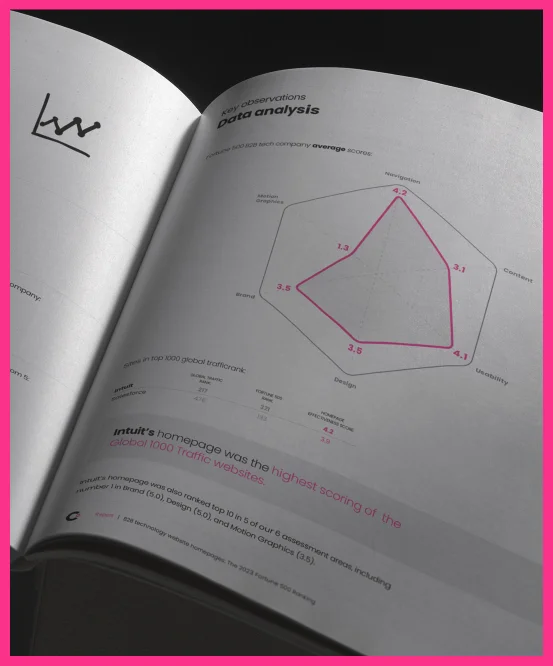Your B2B website has a lot of jobs to do—showing potential customers what your products do, capturing qualified leads, and communicating your brand promise, to name just a few. But before it can do any of those things, it has to be easy to find.
In this article, we’ll explore how UX design plays a crucial role in ensuring visibility and how a well-designed user experience (UX) can help your B2B site rise to the top.
What is B2B website visibility?
For starters, let’s clarify what we’re talking about—because we don’t mean color contrast or accessibility. In this context, visibility refers to a website’s ability to rank well and be discovered by users. To appear in relevant queries and attract high-intent visitors, your site needs to be optimized for search.
It’s worth noting that organic search drives significantly more high-quality traffic than paid efforts. According to BrightEdge Research, B2B companies generate twice as much revenue from organic search as from any other channel; 53% of B2B traffic comes from organic discovery, while paid efforts contribute 15%. Additionally, a study by First Page Sage found that B2B SaaS companies receive an average of 21,140 unique monthly visitors from organic sources, accounting for 41% of their total web traffic.

Why search rankings matter for B2B brands
For B2B tech companies, achieving strong visibility is a major competitive advantage. The market is fierce, and customer acquisition costs are high. If your website ranks well but fails to engage users, you risk losing leads—and revenue. To sustain long-term digital visibility and business growth, make UX a priority.
Strong UX design unlocks a whole host of business benefits:
- Increased organic traffic: Attract a steady stream of high-intent visitors without the rising cost of paid ads.
- Stronger brand authority: Boost your brand reputation and earn more trust—because top-ranking companies are perceived as industry leaders.
- Shorter sales cycles: Move prospects through the funnel faster by making it easy to find relevant, well-structured content.
- Higher ROI: Increase organic visibility over time so you’re less reliant on paid acquisition and pay-per-click (PPC) schemes.
Why search engine optimization(SEO) is more than just keywords & links
In the new digital landscape, any website that isn’t optimized for both engagement and structure risks remaining invisible to B2B prospects and researchers.
Most SEO strategies focus on keywords and backlinks as the primary drivers of ranking. However, modern ranking models now prioritize things like data structure and UX—which includes site speed, navigation, information architecture, content clarity, interaction responsiveness, and functionality. If you’re still relying on keywords and backlinks alone, your strategy is no longer going to be effective.
A well-designed UX isn’t just good for users, it’s essential for search visibility. A poor UX can reduce engagement and make content harder to interpret, lowering visibility over time. In short, UX and visibility success are inseparable—each reinforcing the other by ensuring content is both discoverable and engaging.
Which UX factors impact visibility?
Different search ranking systems prioritize different factors, but all reward well-structured, user-friendly websites. Engagement metrics like bounce rates and session duration matter, and AI models focus more on content clarity, structure, usability, and technical factors like structured data.
To improve visibility, UX designers should focus on:
Engagement & usability signals (UX factors)
- Clear navigation & intuitive design: Helps users find information faster, reducing frustration.
- Page speed & responsiveness: Faster sites keep users engaged and signal high-quality UX.
- Mobile-first design: Mobile-friendly content is prioritized in ranking models.
- Content hierarchy & readability: Well-structured content improves scan-ability and engagement.
- Contextual relevance & semantic optimization: Content should answer queries naturally, not just focus on keywords.
- Clear, concise copywriting: Readable, structured content performs better in rankings and for user engagement.
Our approach: What Clear UX designers focus on
Our team of UX designers understands the ever-evolving nature of search ranking and results. We work hard to stay ahead of the curve so we can deliver next-level digital performance for leading B2B brands like Habu and Riverbed. Here are some of the UX elements we focus on to increase website visibility and discoverability.

Visual hierarchy & content prioritization
Search models tend to surface content that’s well-structured, easy-to-digest, and clear. Poor hierarchy leads to high bounce rates, which negatively impact SEO rankings.
- Ensure important content appears above the fold (without excessive scrolling).
- Enrich coded H1 headlines with keywords.
- Use clear contrast, font sizes, and spacing for easier scanning.
- Place key calls to action (CTAs) strategically to guide user behaviour.
Page layout & design consistency
Users engage more with visually organized pages, improving session duration.
- Use consistent design patterns to improve usability and familiarity.
- Ensure content flows logically with a clean layout.
- Avoid cluttered pages that overwhelm users with too much information.
Internal linking strategy
Search engines use internal links to understand site structure and improve indexing.
- Implement strategic internal links to guide users through content— breadcrumb navigation is helpful for traversing deep site architectures, benefiting internal linking and serving as an additional wayfinding tool.
- Apply thoughtful linking, such as pillar pages and topic clusters, to improve UX by guiding users through related content while helping search engines understand content hierarchy and relevance.
- Ensure linked content is relevant and useful to encourage deep browsing.
- Use information architecture and sitemap design to create the desired user flow between pages.
Search bar & site search UX
If users struggle to find information, they leave quickly—reducing engagement and hurting your rankings.
- Provide fast, accurate search functionality with predictive suggestions.
- Display clear search results with filters to help users refine their queries.
Accessibility-driven UX
Google prioritizes accessible content, and ensuring ADA and WCAG compliance improves usability for all.
- Add contrast-friendly color schemes for better readability.
- Implement screen reader-friendly elements (e.g., proper labeling, ARIA attributes).
Avoiding disruptive UX patterns
Google penalizes sites with intrusive UX elements, such as pop-ups and content that auto-plays.
- Eliminate annoying pop-ups that interrupt users before they engage.
- Avoid excessive ads that slow down the experience.
- Mute auto-play videos unless they’re user initiated.
The evolution of search to AI and its UX needs
With AI-powered ranking models becoming more prevalent, search is shifting from a keyword-driven approach to a context-driven one. AI search platforms such as Google Gemini, Bing AI, and enterprise AI assistants now provide direct, conversational responses instead of just listing links. This evolution brings new UX considerations that businesses must address to stay visible.

To adapt to AI-powered search, focus UX optimization on:
- Conversational content structure – AI models prioritize well-organized, contextually relevant content that answers queries directly. Structuring content using FAQs, clear headings, and concise responses improves AI comprehension and ranking.
- Interaction-based engagement – AI-driven models factor in how users interact with content, making usability, click-through rates (CTR), and dwell time even more crucial. Internal linking and engaging page layouts help retain visitors longer.
- Authority and credibility signals – AI models surface authoritative sources, so trust factors, structured data, and expertise-driven content are essential. Ensure content is well-cited, fact-checked, and includes schema markup to enhance visibility.
- Optimizing for AI-generated summaries – Many AI search engines pull key snippets, lists, and structured responses for featured answers. Using structured data (e.g., Schema.org), bullet points, and scannable formats increases the likelihood of being surfaced in AI responses.
- Content adaptability for voice and conversational search – AI search and voice assistants prioritize natural language and question-based content. Crafting content in Q&A format, using long-tail conversational keywords, and writing in a tone that mimics human dialogue helps match AI-generated responses.
AI-driven search and chat experiences mean businesses must go beyond traditional ranking strategies and focus on delivering structured, intuitive, and engaging user experiences. By aligning UX with these evolving ranking methods, B2B brands can ensure long-term visibility and discoverability in an AI-powered search landscape.
Why UX-driven optimization is the only sustainable strategy
To remain competitive and drive more consistent visibility over a longer period, your site needs to be optimized from a UX perspective—if you’re only thinking about keywords and backlinks, you’re setting yourself up for failure. Lackluster UX drives away users, resulting in low engagement, poor rankings, and less visibility.
Focusing on UX optimization aligns business goals with both traditional and AI-powered discovery, while poor UX makes content harder to interpret, reducing site visibility over time. Our team of UX design experts is ready to help you create a sustainable strategy for long-term search visibility. Let’s get to work.






